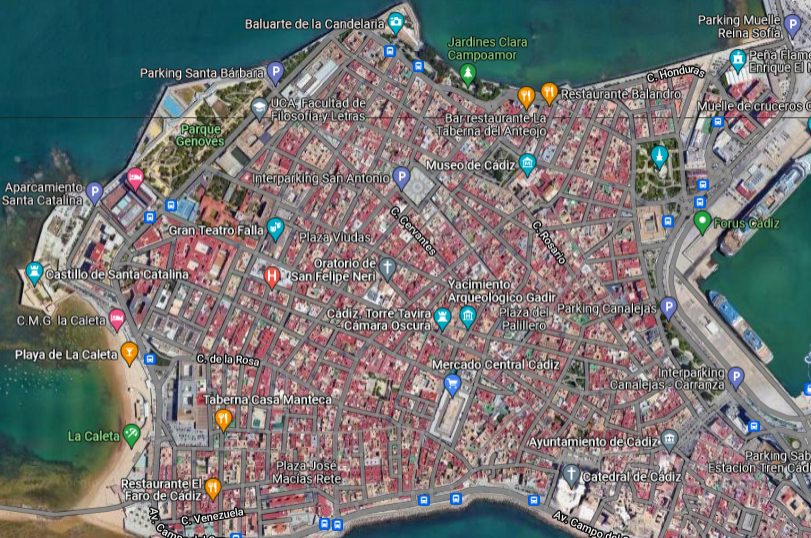Here are a few pointers describing some of the neighborhoods (barrios) in Cádiz city and, some ideas on which hotels, apartments or guest houses to stay in. Each barrio has it’s own unique plazas and gardens that are all worth a visit.
Check out the hotel options in Cádiz over at booking.com
Barrio de la Viña
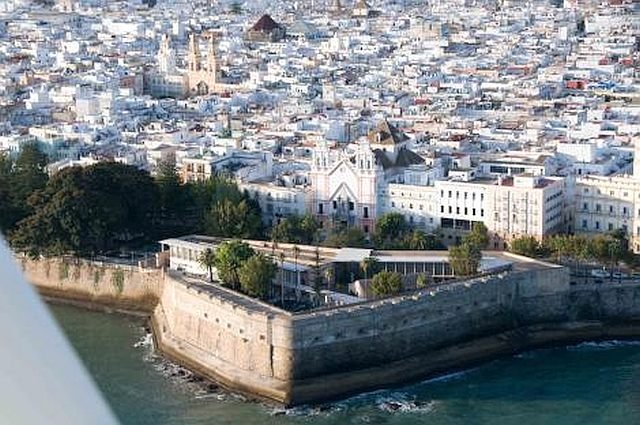
Located close to the Caleta beach, Barrio de la Viña in Cádiz used to be described as a laid back “traditional fishing quarter”. Now it seems to be buzzing with tapas bars, restaurants and a night life (especially flamenco) vibe as well. Seafood, of course is high on the menu!
Every year, vibrant carnival celebrations take place in squares like the Plaza Tío de la Tiza and in the bars along the narrow streets.
Look out for the small park close to the Caleta beach where you can see the famous “Arbol del Mora“, two stunning Australian banyan trees (Ficus macrophylla) that were planted here in 1903.
Accommodation in barrio de la Viña, Cádiz
If you are looking for an apartment for your stay in Cádiz then the Barrio de la Viña is an excellent area located in the older part of the city of Cádiz

Check out availability and prices over at booking.com
Barrio del Mentidero
Situated North of the Barrio la Viña, famous for the Gran Teatro la Falla and the Genovés garden park, the Mentidero neighborhood occupies a good part of the historic center of Cádiz. People spend time eating tapas at the bars in the Plaza Falla before and after the shows in the theatre and the nearby Plaza Fragela is also popular for locals.
The Genovés park is the largest “green” space in the city of Cádiz. It was promoted by Gerónimo Genovés i Puig and is close to the Parador Hotel Atlántico, Paseo de Santa Bárbara, Avenida Duque de Nájera and Calle González Tablas (where the main entrance is located.) The gate, located on this side, allows direct access to a large central avenue, divided into three paths via a double row of symmetrical flower beds. There are impressive specimens of Ficus and Araucaria alongside topiary and a Mediterranean garden setting influenced by ocean traders. I am sure a lot of the plants that are here were brought back by various important members of trading companies.
Not far away is the Alameda Apodaca. This beautiful garden was designed in the 1920s by Juan Talavera Heredia in a characteristic Andalusian style. This explains the use of colored ceramics and tiles, which decorate both the pavement and the edge of the flower beds. As for the vegetation, a superb specimen of ficus and an araucaria stand out, which were planted at the beginning of the 20th century and provide shade for walks through these gardens. There are also magnificent views of the Bay of Cádiz from the Punta Candelaria
Accommodation in barrio del Mentidero, Cádiz
Highly recommended is the Parador of Cádiz. Overlooking the North Atlantic Ocean, this ultra-modern hotel is in the Barrio del Mentidero and all major landmarks in Cádiz such as the Genovés park, the Gran Teatro la Falla, Caleta beach and the Cathedral are within easy walking distances.
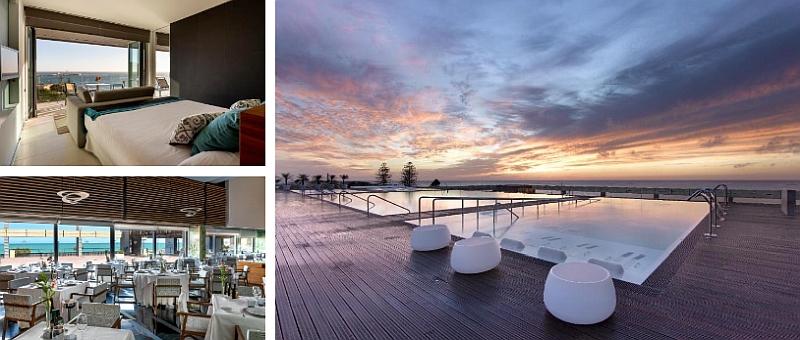
Check out prices and availability for the Parador Hotel in Cádiz here.
Barrio del Pópulo
Cádiz is indeed one of the oldest cities in Europe so this makes the barrio del Pópulo one of the oldest settlements in Europe as it has been permanently inhabited by fishermen and merchants for around 3000 years. It’s one of the smaller barrios in Cádiz city at just a kilometre square but still, there is a lot to see. El Pópulo is dominated by the towering, baroque cathedral and the older, Santa Cruz church.
The area is also defined by its narrow streets lined with gift shops, restaurants and tapas bars. The ancient Roman Theatre is now an open air museums, whilst the striking Arco de los Blanco is one of several atmospheric medieval passageways.
The official Andalucia tourist office is located in the street called Avenida Cuatro de Diciembre de 1977. You will also find the Plaza de San Juan de Dios overlooked by shops, restaurants and bars where you can sit and enjoy tapas. In this square you can also see the church of San Giovanni and also the town hall.
Not far away, the Plaza de la Candelaria, a lovely square with gardens is a great place to relax and watch the world go by.
Accommodation in el barrio del Pópulo, Cádiz
The Hotel Patagonia Sur is located in the historic quarter of barrio del Pópulo ideally situated for visiting Roman ruins, medieval arches, buzzing tapas bars and Cádiz cathedral.
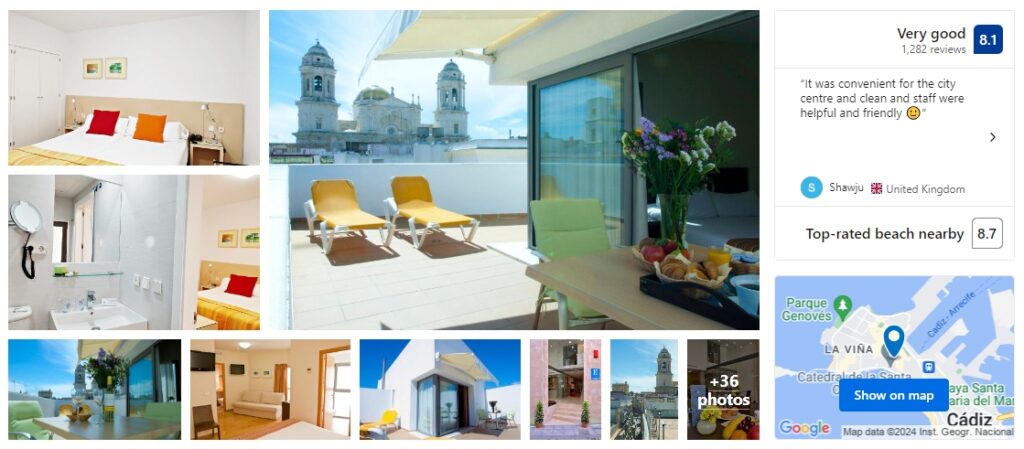
Check out dates and prices for the hotel Patagonia Sur over at booking.com.
Barrio de Santa María
Not far from the train station, the barrio Santa Maria is located by the Puerta de Tierra with narrow almost labyrinthine streets. This is where you will find two interesting museums: The Lithographic Workshop Museum and the Puppet Museum. The convent of Santa María, part of whose façade is decorated with striking tiles in which the Nazarene is represented plays an important role during Holy Week (Semana Santa). The facade was created by the Sevillian artist Andrés de Castillejos at the end of the 17th century.
Flamenco is also very important for the life of this neighborhood. In fact, some of the greats of this art like Enrique El Mellizo, La Perla de Cádiz and Chano Lobato were born here. These and other flamenco artists appear in the names of the streets of the Santa María neighborhood. La Perla de Cádiz is also the name one of the most emblematic clubs in the city where there are performances by some of the best flamenco artists combined with tapas and good wine. The legacy of flamenco artists is also present in the Municipal Center of Flamenco Art , located in the La Merced square. Here, in what was the old neighborhood food market, numerous shows are scheduled throughout the year.
Accommodation in Barrio de Santa María, Cádiz
Apartamento la Goleta is ideally located close to train and bus stations and the main beaches and monuments of Cádiz are within easy walking distance.
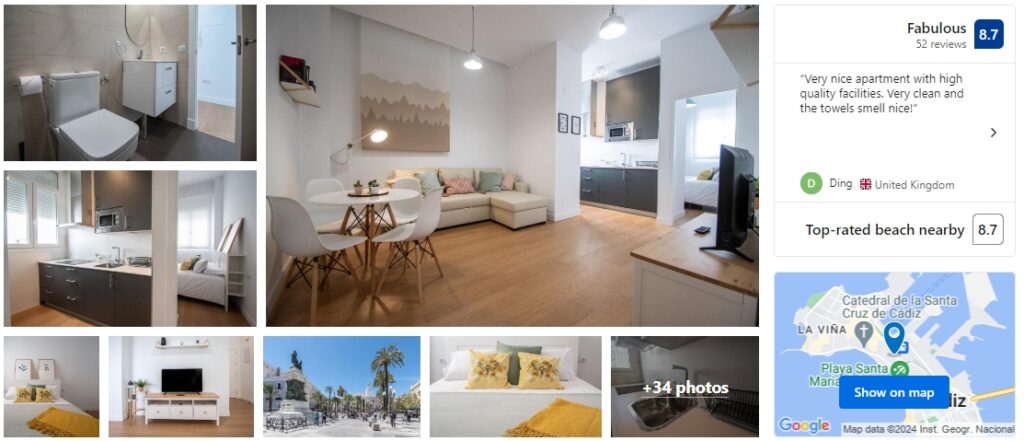
Check out dates and prices for La Goleta apartment over at booking.com.
Exploring the Neighborhoods of Cádiz – Visitor FAQ
Cádiz’s neighborhoods offer an authentic look into the city’s cultural heartbeat. Each barrio reveals a unique side of Cádiz—its ancient roots, maritime history, local traditions, and daily life. Exploring these areas gives visitors deeper insight beyond the monuments, connecting them to the rhythm of local streets, markets, and communities.
El Pópulo
The oldest neighborhood in Cádiz, dating back to Roman and medieval times. It’s a labyrinth of narrow alleys, archways, and stone buildings. Highlights include the Cathedral of Cádiz, Roman Theatre, and charming tapas bars tucked into ancient walls.
La Viña
Known for its vibrant atmosphere and deep ties to the Cádiz Carnival. Originally a fishing quarter, La Viña is now packed with bars, seafood restaurants, and flamenco flair. Its heart is the Plaza de la Cruz Verde, and it’s a short walk from La Caleta beach.
Santa María
This historic neighborhood is one of the cradles of flamenco in Cádiz. Though quieter than La Viña, it has deep cultural roots, music-filled streets, and local bars. The Oratorio de San Felipe Neri is a key attraction nearby.
Mentidero
A peaceful and central barrio near parks and plazas like Plaza Fragela and Plaza San Antonio. It’s home to the Gran Teatro Falla and has a mix of elegant townhouses, schools, and cafés. Ideal for a calm stroll close to major attractions.
San Carlos
An upper-class residential district developed in the 18th century, San Carlos features wide boulevards, neoclassical architecture, and monuments like the Plaza de España and the Monument to the Constitution of 1812.
Paseo Marítimo & New Cádiz
Stretching along the city’s long beach coastline, this modern area is perfect for beach lovers. It includes Playa de la Victoria, wide promenades, newer apartments, and beach bars (chiringuitos) that come alive in summer.
Extramuros
Meaning “outside the walls,” this area extends beyond the historic center. It includes parks, residential zones, the main train station, and cultural spots like the Congress Palace of Cádiz (formerly the Tobacco Factory).
Authentic Culture: Each neighborhood brings you closer to the daily life of Gaditanos (locals).
Architecture & History: From Roman ruins to 18th-century facades and Art Deco buildings.
Local Food & Drink: Discover tapas bars, seafood eateries, and family-run cafés.
Festivals & Flamenco: Especially in La Viña and Santa María during Carnival or summer events.
Yes, guided walking tours offer an immersive experience through the history and charm of Cádiz’s barrios. Some audio tours also cover specific districts like El Pópulo or La Viña, offering flexible, self-paced exploration.
The Visiting Cádiz website includes:
Where to stay: Hotels, apartments, house rentals, and hostels.
Getting to Cádiz: Transport options and parking details.
What to see and do: Monuments, guided tours, activities, and neighborhoods.
Where to eat and shop: Local markets, food tours, and restaurant tips.
Yes, a guide titled “Discovering the Charms of Cádiz: A Guide for Cruise Passengers“ is available, providing tailored suggestions based on limited time in port. It includes the top neighborhoods to explore on foot.
Cádiz’s barrios offer something for everyone:
Families: The beachside areas, parks in Extramuros, and open plazas are ideal.
Couples: La Viña and El Pópulo offer romantic charm and atmospheric evenings.
Solo Travelers: Safe and walkable with many guided and self-guided tour options.
